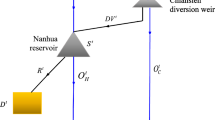Abstract
This study derives optimal hedging rules for simultaneously minimizing short- and long-term shortage characteristics for a water-supply reservoir. Hedging is an effective measure to reduce a high-percentage single period shortage, but at a cost of more frequent small shortages. Thus simultaneously minimizing the maximum monthly shortage and the shortage ratio (defined as the ratio of total shortages to total demands) over the analysis horizon is the operation goal of a water-supply reservoir to derive optimal hedging rules. Two types of hedging are explored in this study: the first uses water availability defined as storage plus inflow, while the second depends on the potential shortage conditions within a specific future lead-time period. The compromise programming is employed to solve this conflicting multiobjective problem. The optimal hedging rules under given reservoir inflow are derived first. Because future inflow cannot be known exactly in advance, the monthly decile inflows are suggested as a surrogate for forecast of future inflows in hedging rules for real-time reservoir operations. The results show that the suggested method can effectively achieve the reservoir operation goal. The merits of the proposed methodology are demonstrated with an application to the Shihmen reservoir in Taiwan.
Similar content being viewed by others
References
American Water Works Association (AWWA), 2002, Drought Management Handbook, American Water Works Association, Denver, Colorado.
Bayazit, M. and Unal, N. E., 1990, ‘Effects of hedging on reservoir performance’, Water Resour. Res. 26(4), 713–719.
Cancelliere, A., Ancarani, A. and Rossi, G., 1998, ‘Susceptibility of watersupply reservoir to drought conditions’, J. Hydro. Eng. 3(2), 140–148.
Datta, B. and Houck, M. H., 1984, ‘A stochastic optimization model for real-time operations of reservoirs using uncertain forecasts’, Water Resour. Res. 20(8), 1039–1046.
Draper, A. J. and Lund, J. R., 2004, ‘Optimal hedging and carryover storage value’, J. Water Resour. Plan. Manage. 130(1), 83–87.
Duckstein, L. and Opricovic, S., 1980, ‘Multiobjective optimization in river basin development’, Water Resour. Res. 16(1), 14–20.
Goicoechia, A., Hansen, D. R. B. and Duckstein, L., 1982, Multiobjective Decision Analysis with Engineering and Business Applications, Wiley, New York, U.S.A.
Hashimoto, H., Stedinger, J. R. and Loucks, D. P., 1982, ‘Reliability, resiliency, and vulnerability criteria for water resources system performance evaluation’, Water Resour. Res. 18(1), 14–20.
Kuo, Y. C., 2002, ‘Lessens learned from 2002 droughts in Taiwan’, J. Water Resour. Manage. 4(3), 2–9 (in Chinese).
Lund, J. R. and Reed, R. U., 1995, ‘Drought water rationing and transferable rations’, J. Water Resour. Plan. Manage. 121(6), 429–437.
Maass, A., Hufschmidt, M. M., Dorfman, R., Thomas Jr., H. A., Marglin, S. A. and Fair, G. M., 1962, Design of Water Resources System, Harvard University Press, Cambridge, MA., U.S.A.
Neelakantan, T. R. and Pundarikanthan, N. V., 1999, ‘Hedging rule optimization for water supply reservoir system’, Water Resour. Manage. 13(6), 409–426.
Oliveira, R. and Loucks, D. P., 1997, ‘Operating rules for multireservoir systems’, Water Resour. Res. 33(4), 839–852.
Shiau, J. T., 2003, ‘Water release policy effects on the shortage characteristics for the Shihmen reservoir system during droughts’, Water Resour. Manage. 17(6), 463–480.
Shih, J. S. and ReVelle, C., 1994, ‘Water-supply operations during drought: Continuous hedging rule’, J. Water Resour. Plan. Manage. 120(5), 613–629.
Shih, J. S. and ReVelle, C., 1995, ‘Water supply operations during drought: A discrete hedging rule’, Eur. J. Oper. Res. 82, 163–175.
Simonovic, S. P. and Burn, D. H., 1989, ‘An improved methodology for short-term operation of a single multipurpose reservoir’, Water Resour. Res. 25(1), 1–8.
Simonovic, S. P., Venema, H. D. and Burn, D. H., 1992, ‘Risk-based parameter selection for short-term reservoir operation’, J. Hydrol. (Amst.) 131, 269–291.
Srinivasan, K. and Philipose, M. C., 1996, ‘Evaluation and selection of hedging policies using stochastic reservoir simulation’, Water Resour. Manage. 10(3), 163–188.
Srinivasan, K. and Philipose, M. C., 1998, ‘Effect of hedging on over-year reservoir performance’, Water Resour. Manage. 12(2), 95–120.
Tickle, K. and Goulter, I. C., 1992, ‘Assessment of Performance Metrics for a Reservoir Under Stochastic Conditions’, Proceedings of the 6th IAHR International Symposium on Stochastic Hydraulics, Taipei, pp. 583–590.
Xu, Z., Jinno, K., Kawamura, A., Takesaki, S. and Ito, K., 1998, ‘Performance risk analysis for Fukuoka water supply system’, Water Resour. Manage. 12(1), 13–30.
Yeh, W-G. W. and Becker, L., 1982, ‘Worth of inflow forecast for reservoir operation’, J. Water Resour. Plan. Manage. 108(3), 257–269.
Zeleny, M., 1973, ‘Compromise programming’, in J. L. Cochrane and M. Zeleny (eds.), Multiple Criteria Decision Making, University of South Carolina Press, Columbia.
Author information
Authors and Affiliations
Corresponding author
Rights and permissions
About this article
Cite this article
Shiau, J.T., Lee, H.C. Derivation of Optimal Hedging Rules for a Water-supply Reservoir through Compromise Programming. Water Resour Manage 19, 111–132 (2005). https://doi.org/10.1007/s11269-005-1502-6
Received:
Accepted:
Issue Date:
DOI: https://doi.org/10.1007/s11269-005-1502-6




